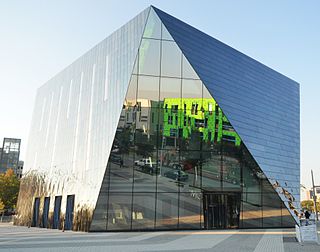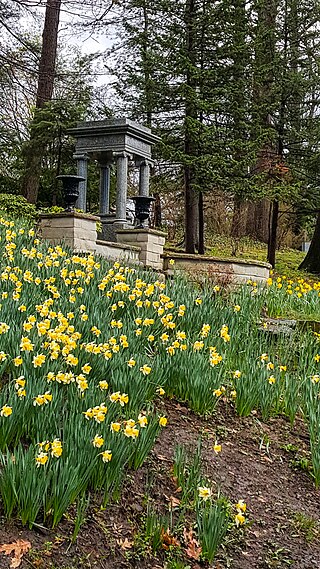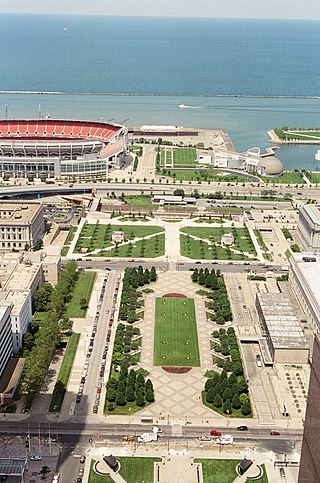Related Research Articles
The J. Paul Getty Trust is the world's wealthiest art institution, with an estimated endowment of US$7.7 billion in 2020. Based in Los Angeles, California, it operates the J. Paul Getty Museum, which has two locations—the Getty Center in the Brentwood neighborhood of Los Angeles and the Getty Villa in the Pacific Palisades neighborhood of Los Angeles. Its other programs are the Getty Foundation, the Getty Research Institute, and the Getty Conservation Institute.
WVIZ is a PBS member television station in Cleveland, Ohio, United States. It is owned by Ideastream Public Media alongside classical music station WCLV and co-managed with Kent State University–owned WKSU, the NPR member for both Cleveland and Akron. The three stations share studio facilities at the Idea Center on Playhouse Square in Downtown Cleveland; WVIZ's transmitter is located in suburban Parma, Ohio.
Gordon Gund is an American businessman and professional sports owner. He is the CEO of Gund Investment Corporation. He is the former co-owner of the San Jose Sharks from 1992 to 2002, former principal owner of the Cleveland Cavaliers from 1983 to 2005, and former principal owner of the Cleveland Rockers from 1997 to 2003. Gund lost his sight to retinitis pigmentosa and was a co-founder of Foundation Fighting Blindness.
WCPN is a non-commercial educational radio station licensed to Lorain, Ohio, featuring a public radio format as a repeater of Kent–licensed WKSU. Owned by Ideastream Public Media, the station serves the western portion of Greater Cleveland and parts of surrounding Northeast Ohio. By virtue of WKSU, studios are located at Playhouse Square in Downtown Cleveland, while WCPN's transmitter resides in the Cleveland suburb of Avon. In addition to a standard analog transmission, WCPN broadcasts over four HD Radio channels and streams online.

The Museum of Contemporary Art Cleveland is a contemporary art museum in Cleveland, Ohio, United States. It is the only contemporary art venue of its kind in Metropolitan Cleveland. The organisation was founded by Marjorie Talalay, Agnes Gund, and Nina Castelli Sundell in 1968 and has undergone several name and venue changes in the years following its 1968 founding. Originally known as The New Gallery, the museum was rebranded as the Cleveland Centre for Contemporary Art in 1984. The gallery has operated under its current branding as the Museum of Contemporary Art Cleveland (moCa) since 2002.

Arter & Hadden LLP was a Cleveland, Ohio-based law firm that traced its founding to 1843 and ceased operations on July 15, 2003. When the firm closed, it was one of the oldest continuing operating law firms in the country. The firm had engaged in an ambitious expansion throughout the 1990s, peaking in 1999 with a total of 425 attorneys employed by the firm. Additionally, Arter and Hadden had opened offices in Columbus, Ohio, Dayton, Ohio, Washington, DC, Dallas, Texas, Los Angeles, California, Irvine, California and through acquisitions and mergers opened offices in San Francisco and San Diego, California.
Jeffry M. Picower was an American investor involved in the Madoff investment scandal. He was the largest beneficiary of Madoff's Ponzi scheme, and his widow agreed to have his estate settle the claims against it by Madoff trustee Irving Picard for $7.2 billion, the largest single forfeiture in American judicial history.

The James A. Garfield Memorial is a memorial for and the final resting place of assassinated President James A. Garfield, located in Lake View Cemetery in Cleveland, Ohio. The memorial, which began construction in October 1885 and was dedicated on May 30, 1890, exhibits a combination of Byzantine, Gothic, and Romanesque Revival architectural styles. Garfield, former First Lady Lucretia Garfield, and two other members of the Garfield family are entombed in the crypt level of the monument.
Agnes Gund is an American philanthropist and arts patron, collector of modern and contemporary art, and arts education and social justice advocate. She is President Emerita and Life Trustee of the Museum of Modern Art (MoMA) and Chairman of its International Council. She is a board member of MoMA PS1. In 1977, in response to New York City's fiscal crisis that led to budget cuts that virtually eliminated arts education in public schools, Gund founded Studio in a School, a nonprofit organization that engages professional artists as art instructors in public schools and community-based organizations to lead classes in drawing, printmaking, painting, collage, sculpture, and digital media, and to work with classroom teachers, administrators, and families to incorporate visual art into their school communities.

Lake View Cemetery is a privately owned, nonprofit garden cemetery located in the cities of Cleveland, Cleveland Heights, and East Cleveland in the U.S. state of Ohio. Founded in 1869, the cemetery was favored by wealthy families during the Gilded Age, and today the cemetery is known for its numerous lavish funerary monuments and mausoleums. The extensive early monument building at Lake View helped give rise to the Little Italy neighborhood, but over-expansion nearly bankrupted the burial ground in 1888. Financial recovery only began in 1893, and took several years. Lake View grew and modernized significantly from 1896 to 1915 under the leadership of president Henry R. Hatch. The cemetery's cautious management allowed it to avoid retrenchment and financial problems during the Great Depression.
George Gund II was an American banker, business executive, and real estate investor who lived in Cleveland, Ohio, in the United States. He inherited his father's fortune and used a portion of it to purchase alien property seized during World War I. He sold this business at significant profit, and invested widely in banking, insurance, and real estate. Among his investments were a large number of shares in the then-small Cleveland Trust Company. Gund became a director of the bank in 1937 and president in 1941. He led the transformation of the institution into one of the largest banks in the United States. He retired as president in 1962, and was named chairman of the board of directors. A philanthropist for most of his life, he established The George Gund Foundation in 1952.
Chaim Schochet is an American real estate executive, developer, and manager at Optima Ventures, once the largest holder of real estate in Downtown Cleveland.

Robert L. Stark is an American real estate developer and founder and chief executive officer of Stark Enterprises.

The Cleveland Trust Company Building is a 1907 building designed by George B. Post and located at the intersection of East 9th Street and Euclid Avenue in downtown Cleveland's Nine-Twelve District. The building is a mix of Beaux-Arts, Neoclassical, and Renaissance Revival architectural styles. It features a glass-enclosed rotunda, a tympanum sculpture, and interior murals.

The Cleveland Convention Center was located in downtown Cleveland, Ohio. Built by the city of Cleveland beneath the Cleveland Mall adjacent to Public Auditorium, it was completed in 1964. Plans for the convention center were first made in 1956, but voters twice rejected initiatives to fund construction before approving a bond levy in November 1963. A local private foundation donated several million dollars to beautify the mall atop the convention center with a reflecting pool and fountains.

Bertram Leonard Wolstein, known to his friends as Bart and publicly as Bert L. Wolstein, was an American real estate developer, sports team owner, and philanthropist based in Cleveland, Ohio. He founded Developers Diversified Realty Corporation, which at the time of his death was the 4th-largest developer of shopping centers in the United States. In 1979, he purchased the Cleveland Force Major Indoor Soccer League team, and attempted to purchase the Cleveland Browns in 1998. He retired from active business in 1997, and became one of the most generous donors in the United States in his final years.

Woodland Cemetery is a historic rural cemetery located at 6901 Woodland Avenue in Cleveland, Ohio. Established in 1853, it became Cleveland's main public cemetery after its founding and remained so for the next half-century. It fell into extreme disrepair, and most of its outstanding architectural features dismantled or demolished. In 1986, Woodland Cemetery was added to the National Register of Historic Places. The cemetery has since undergone restoration.

The Union Miles Development Corporation is a nonprofit community development corporation serving the Union-Miles Park statistical planning area in Cleveland, Ohio, in the United States. Created in 1981 by the Union Miles Community Coalition, it was successful in drawing national attention to discriminatory practices in lending practices and won passage of an Ohio law reforming housing foreclosure procedures.

The Cleveland Foundation Centennial Lake Link Trail, originally known as the Lake Link Trail, is a cycling, hiking, and walking trail located in the city of Cleveland, Ohio, in the United States. Owned by the city of Cleveland and maintained by Cleveland Metroparks, the trail runs along the former track bed of the Cleveland and Mahoning Valley Railroad. The trail is named for The Cleveland Foundation, a local community foundation which donated $5 million toward the trail's construction. The southern leg of the 1.3-mile (2.1 km) trail opened in August 2015, and the northern leg in August 2017. The middle leg will begin construction once the Irishtown Bend hillside is stabilized. A bridge connecting the trail to Whiskey Island will begin construction in Spring 2019 and will be completed in early Summer 2020.

The Cleveland and Mahoning Valley Railroad (C&MV) was a shortline railroad operating in the state of Ohio in the United States. Originally known as the Cleveland and Mahoning Railroad (C&M), it was chartered in 1848. Construction of the line began in 1853 and was completed in 1857. After an 1872 merger with two small railroads, the corporate name was changed to "Cleveland and Mahoning Valley Railroad". The railroad leased itself to the Atlantic and Great Western Railway in 1863. The C&MV suffered financial instability, and in 1880 its stock was sold to a company based in London in the United Kingdom. A series of leases and ownership changes left the C&MV in the hands of the Erie Railroad in 1896. The CM&V's corporate identity ended in 1942 after the Erie Railroad completed purchasing the railroad's outstanding stock from the British investors.
References
- Notes
- ↑ A number of sources claim Gund's fortune was actually $600 million. The New York Times mentioned an anecdote about Gund's $600 million fortune in a 1971 article. [12] Robert A. Musson, a historian of the Cleveland brewing scene, wrote in 2005 that Gund was worth $600 million at the time of his death. [3] The magazine Vanity Fair even claimed that Gund gave $600 million to the George Gund Foundation in 1952. [13] Musson's claim is contradicted by the findings of the probate court, which found an estate worth just $25 million. [14] The Vanity Fair claim is contradicted by tax reports the foundation made to the U.S. federal government, which showed only about a $24 million donation after Gund's death. [14] [15] [16]
- ↑ Gund had donated some of his fortune to the Gund Foundation, and distributed most of the rest to three trusts which benefitted his children. [15]
- ↑ $18.9 million of Gund's estate consisted of stock. According to The Plain Dealer newspaper, the largest holdings were $8.7 million of Kellogg's stock, $1.5 million in Traveler's Corp. stock, $1.15 million in Northern Life Insurance Company stock, and $1.05 million in Standard Oil stock. [10]
- ↑ Stark became a trustee of the foundation in the early 1960s. Gordon Gund became a trustee in 1965. [22]
- ↑ Assets were $15.75 million in 1968 [17] and $56 million ($392 million in 2022 dollars) in 1972. [22]
- ↑ Gordon Gund developed retinitis pigmentosa in the 1960s and was blind by 1970. [33] The Foundation Fighting Blindness does extensive research into retinitis pigmentosa. [32]
- ↑ University Circle, Inc. is a nonprofit corporation which acts as an economic development organization, advocacy and lobbying agent, and area service provider for member institutions and businesses in Cleveland's University Circle neighborhood. [35]
- Citations
- 1 2 Soder, Chuck (September 15, 2019). "Foundations on list post 10.6% increase in giving". Crain's Cleveland Business. Retrieved June 20, 2020.
- ↑ Silverman et al. 2016, p. 81.
- 1 2 Musson 2005, p. 37.
- ↑ Okrent 2010, p. 99.
- ↑ "Kaffee-Hag Corporation Sold". Tea and Coffee Trade Journal. June 1919. p. 540. Retrieved June 19, 2020; ""Kaffee-Hag" Shares Sold By Alien Property Custodian". Simmons' Spice Mill. June 1919. p. 725. Retrieved June 19, 2020.
- ↑ Subcommittee of the Committee on Ways and Means; Subcommittee of the Committee on Foreign Relations (1926). Return of Alien Property. United States House of Representatives. 69th Cong., 1st sess. Washington, D.C.: Government Printing Office. p. 31.
- ↑ Metcalf, Tom (November 30, 2017). "Coffee Heir Became A Billionaire With An Early Bet On Invisalign". Private Wealth Magazine. Retrieved June 19, 2020.
- ↑ Maggard 1993, p. 31.
- ↑ Cigliano 1993, p. 304.
- 1 2 Nussbaum, John (March 1, 1967). "Three Forgeries Uncovered in Gund's Art Collection". The Plain Dealer. p. 33.
- ↑ "Gund Funds: Giving It Away". The Plain Dealer. February 10, 1991. p. 39.
- ↑ Hershey, Robert D. Jr. (December 26, 1971). "Shadow of the Old School". The New York Times. Retrieved June 18, 2020.
- ↑ Colacello, Bob (December 2015). "Agnes Gund, Art's Grande Dame, Still Has Work to Do". Vanity Fair. Retrieved June 18, 2020.
- 1 2 3 "Gund's Estate Nets Ohio a Mere $9,091". The Plain Dealer. August 18, 1967. p. 5.
- 1 2 3 "Foundation to Receive Bulk of Gund's Estate". The Plain Dealer. November 29, 1966. p. 2.
- 1 2 "Gund Leaves Millions to Charity". Mansfield News-Journal. November 30, 1966. p. 11.
- 1 2 Select Committee on Small Business (June 30, 1969). Tax-Exempt Foundations and Charitable Trusts: Their Impact on Our Economy. Seventh installment. Subcommittee Chairman's Report to Subcommittee No. 1. Select Committee on Small Business. United States House of Representatives. 91st Cong., 1st sess. Washington D.C.: U.S. Government Printing Office. p. 118. hdl:2027/umn.31951d03558743o.
{{cite book}}:|author=has generic name (help) - ↑ Hammack & Smith 2018, p. 133.
- ↑ "Top Funds Are Listed". The Plain Dealer. April 10, 1966. p. 9.
- 1 2 3 4 5 Keele & Kiger 1984, p. 156.
- ↑ Huszar, Kenneth D. (February 3, 1967). "Gund Foundation Chief Is Civic Minded". The Plain Dealer. p. 26.
- 1 2 3 4 Barmann, George J. (March 26, 1972). "Gund Foundation Helps Enrich Cleveland Area". The Plain Dealer. p. AA1.
- 1 2 3 4 "James Lipscomb, director of the Gund Foundation". The Plain Dealer. June 6, 1987. p. B9.
- ↑ Taft Foundation Reporter. Washington, D.C.: Taft Corp. 1983. p. 239. OCLC 7024931.
- 1 2 "New Chief at Gund Foundation". The Plain Dealer. September 2, 1988. p. B3.
- ↑ "Gund President". The Plain Dealer. March 13, 1973. p. A16.
- 1 2 3 4 5 6 Kilpatrick, Mary (November 13, 2019). "Geoffrey Gund to retire as Gund Foundation president, Catherine Gund to take over". The Plain Dealer. Retrieved June 20, 2020.
- ↑ "Development Aide Accepts Job". Pittsburgh Press. November 5, 1988. p. C3; Sheehan, Andrew (November 5, 1988). "Leader in Allegheny Conference to Quit". Pittsburgh Post-Gazette. p. 4.
- ↑ Maggard 1993, p. 235.
- ↑ "Frederick Cox, Banker, George Gund Advisor". The Plain Dealer. February 13, 1994. p. B10.
- ↑ O'Connor, Clint (July 20, 1996). "Public Gets Peek at Science Center". p. A10.
- 1 2 3 Patton, Susan Ruiz (September 26, 2002). "Gund Foundation marks 50 years". The Plain Dealer. p. B6.
- ↑ Grimsley, Will (November 8, 1978). "Inner Vision". Bowling Green Daily News. p. B4.
- 1 2 "Gund Foundation picks Abbott". Crain's Cleveland Business. October 10, 2002. Retrieved June 19, 2020.
- ↑ "University Circle Inc. (UCI)". Encyclopedia of Cleveland. 2020. Retrieved June 20, 2020.
- ↑ "Nation's First County-Level Pay for Success Program Aims to Reconnect Foster Children with Caregivers in Stable, Affordable Housing- Office of the Cuyahoga County Executive". executive.cuyahogacounty.us. Retrieved 2020-10-29.
- ↑ Washington, Roxanne; Dealer, The Plain (2019-11-13). "Geoffrey Gund to retire from The George Gund Foundation after 43 years". cleveland. Retrieved 2020-10-22.
- ↑ Glenn, Brandon. (July 11, 2005.) “Gund Foundation awards grants.” Crain’s Cleveland Business.